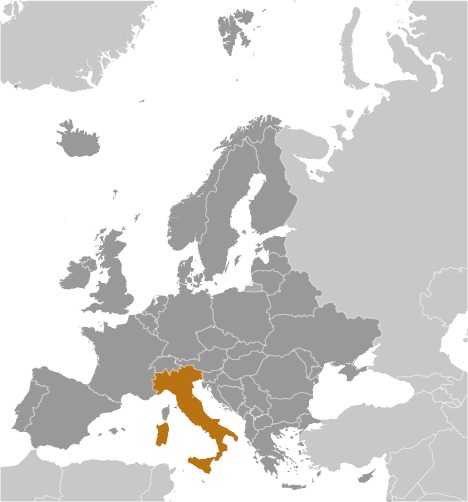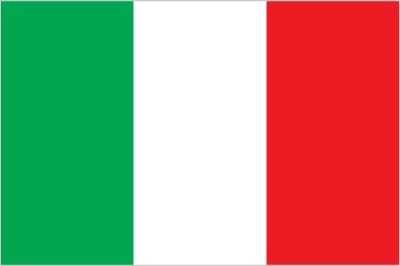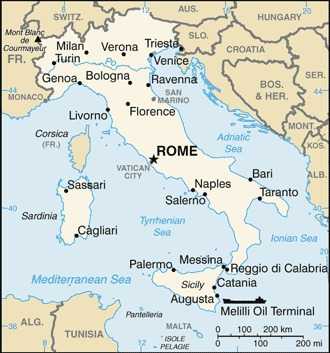Introduction
Background
Italy became a nation-state in 1861 when the regional states of the peninsula, along with Sardinia and Sicily, were united. Italy is a charter member of NATO, as well as the European Economic Community (EEC) and its successors, the EC and the EU. Italy joined the Economic and Monetary Union in 1999.
Geography
Area
total : 301,340 sq km
land: 294,140 sq km
water: 7,200 sq km
Climate
predominantly Mediterranean; alpine in far north; hot, dry in south
Natural resources
coal, antimony, mercury, zinc, potash, marble, barite, asbestos, pumice, fluorspar, feldspar, pyrite (sulfur), natural gas and crude oil reserves, fish, arable land
People and Society
Population
total: 60,964,931
Ethnic groups
Italian (includes small clusters of German-, French-, and Slovene-Italians in the north, Albanian-Italians, Croat-Italians, and Greek-Italians in the south)
Languages
Italian (official), German (parts of Trentino-Alto Adige region are predominantly German-speaking), French (small French-speaking minority in Valle d'Aosta region), Slovene (Slovene-speaking minority in the Trieste-Gorizia area), Croatian (in Molise)
Religions
Christian 80.8% (overwhelmingly Roman Catholic with very small groups of Jehovah's Witnesses and Protestants), Muslim 4.9%, unaffiliated 13.4%, other 0.9% (2020 est.)
Population growth rate
-0.08% (2024 est.)
Government
Government type
parliamentary republic
Capital
name: Rome
Executive branch
chief of state: President Sergio MATTARELLA (since 3 February 2015)
head of government: Prime Minister Giorgia MELONI (since 22 October 2022); the prime minister's official title is President of the Council of Ministers
Legislative branch
description: bicameral Parliament or Parlamento consists of:
Senate or Senato della Repubblica (205 seats; 122 members in multi-seat constituencies directly elected by proportional representation vote, 74 members in single-seat constituencies directly elected by plurality vote, 4 members in multi-seat constituencies abroad directly elected by proportional representation vote, and 5 members appointed by the president of Italy; all members serve 5-year terms)
Chamber of Deputies or Camera dei Deputati (400 seats; 245 members directly elected in multi-seat constituencies by proportional representation vote; 147 members directly elected in single-seat constituencies by plurality vote and 8 members in multi-seat constituencies abroad directly elected by proportional representation vote; members serve 5-year terms)
Economy
Economic overview
core EU economy; strong services, manufacturing, and tourism sectors; sustained recovery in post-COVID inflationary environment; high public debt levels; increasing poverty levels particularly in poorer south; strong exports to EU and US partners
Real GDP (purchasing power parity)
$3.097 trillion (2023 est.)
$3.068 trillion (2022 est.)
$2.951 trillion (2021 est.)
Real GDP per capita
$52,700 (2023 est.)
$52,100 (2022 est.)
$49,900 (2021 est.)
Agricultural products
milk, grapes, wheat, tomatoes, maize, apples, olives, oranges, potatoes, pork (2022)
Industries
tourism, machinery, iron and steel, chemicals, food processing, textiles, motor vehicles, clothing, footwear, ceramics
Exports
$793.589 billion (2023 est.)
$752.864 billion (2022 est.)
$691.428 billion (2021 est.)
Exports - partners
Germany 12%, US 11%, France 10%, Spain 5%, UK 4% (2022)
Exports - commodities
packaged medicine, refined petroleum, garments, cars, vehicle parts/accessories (2022)
Imports
$756.154 billion (2023 est.)
$785.549 billion (2022 est.)
$644.93 billion (2021 est.)
Imports - partners
Germany 14%, France 8%, China 8%, Netherlands 5%, Spain 5% (2022)
Imports - commodities
natural gas, crude petroleum, cars, packaged medicine, garments (2022)
Exchange rates
euros (EUR) per US dollar -
Page last updated: Wednesday, July 24, 2024




